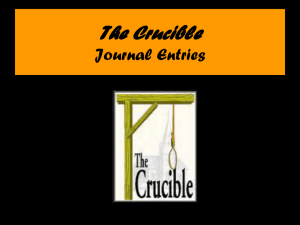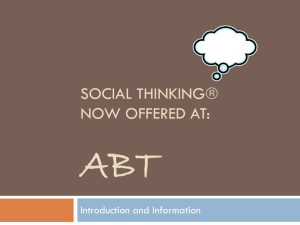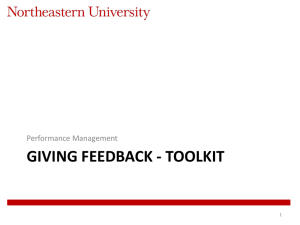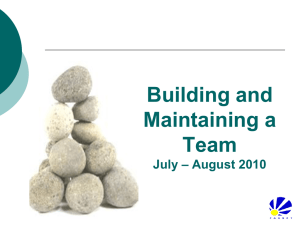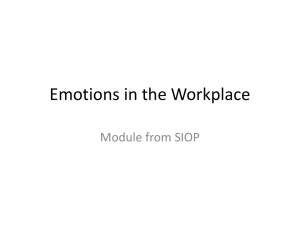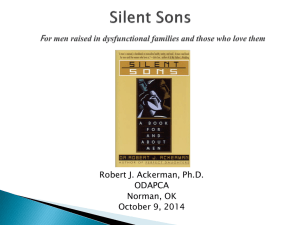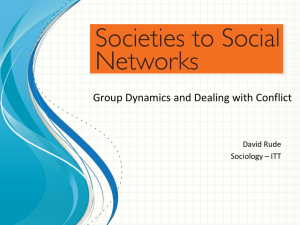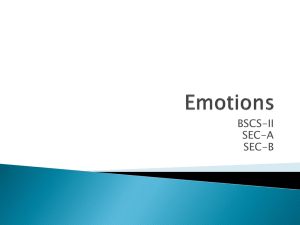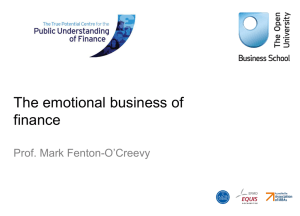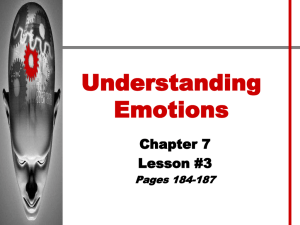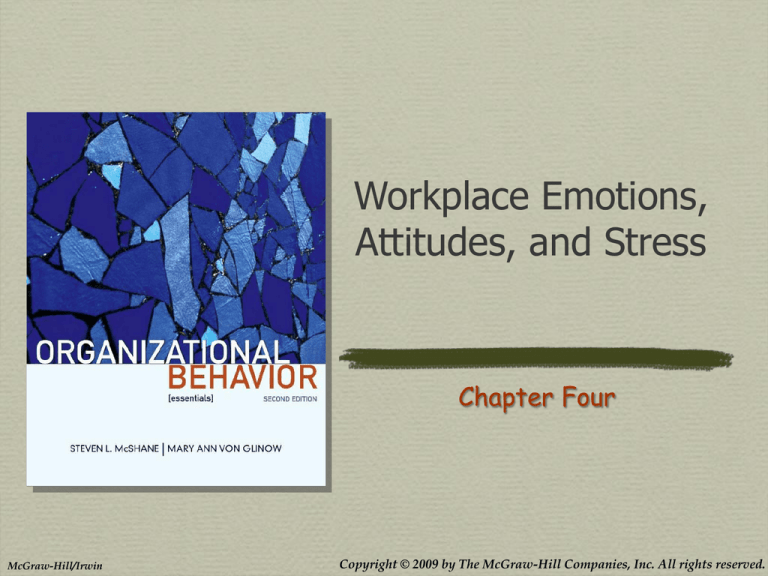
Workplace Emotions,
Attitudes, and Stress
Chapter Four
McGraw-Hill/Irwin
Copyright © 2009 by The McGraw-Hill Companies, Inc. All rights reserved.
Serious Fun at Cxtec
Cxtec employees live up to
their company values,
which include having fun at
work.
Helium-filled balloons adorn
the office.
Work-life balance.
Miniature golf tournaments
along the hallway.
Courtesy of CXtec
4-2
Emotions Defined
Psychological, behavioral,
and physiological episodes
experienced toward an
object, person, or event
that create a state of
readiness.
Most emotions occur
without our awareness
Courtesy of CXtec
4-3
Attitudes versus Emotions
Attitudes
Judgments about an
attitude object
Based mainly on
rational logic
Usually stable for days
or longer
Emotions
Experiences related to an
attitude object
Based on innate and learned
responses to environment
Usually experienced for
seconds or less
4-4
Traditional Model of Attitudes
Purely cognitive approach
Beliefs: established perceptions of attitude object
Feelings: calculation of good or bad based on beliefs
about the attitude object
Behavioral intentions: motivation to act in response to
the attitude object
Problem: Ignores important role of emotions in
shaping attitudes
4-5
Emotions, Attitudes and Behavior
Perceived Environment
Cognitive
process
Emotional
process
Beliefs
Attitude
Emotional
Episodes
Feelings
Behavioral
Intentions
Behavior
4-6
Role of Emotions in Attitudes
Feelings toward attitude object influenced by
cumulative emotional episodes toward it
We ‘listen in’ on our emotions while thinking
through what we like or dislike
Cognitive and emotional processes don’t always
agree with each other
Emotions also directly affect behavior
e.g. facial expression
4-7
Generating Positive Emotions at Work
The emotions-attitudesbehavior model illustrates
that attitudes are shaped by
ongoing emotional
experiences.
Thus, successful companies
actively create more positive
than negative emotional
episodes.
Courtesy of CXtec
4-8
Cognitive Dissonance
A state of anxiety that occurs when an individual’s
beliefs, feelings and behaviors are inconsistent
with one another
Most common when behavior is:
known to others
done voluntarily
can’t be undone
4-9
Emotional Labor and
Emotional Intelligence
Workplace Emotions,
Attitudes, and Stress
McGraw-Hill/Irwin
Copyright © 2009 by The McGraw-Hill Companies, Inc. All rights reserved.
Emotional Labor
Effort, planning and control needed to express
organizationally desired emotions during
interpersonal transactions.
Emotional labor higher when job requires:
frequent and long duration display of emotions
displaying a variety of emotions
displaying more intense emotions
4-11
Emotional Labor Across Cultures
Displaying or hiding emotions varies across
cultures
Minimal emotional expression and monotonic voice in
Korea, Japan, Austria
Encourage emotional expression in Kuwait, Egypt, Spain,
Russia
4-12
Emotional Labor Challenges
Difficult to display expected emotions accurately,
and to hide true emotions
Emotional dissonance
Conflict between true and required emotions
Potentially stressful with surface acting
Less stress through deep acting
4-13
Emotional Intelligence Defined
Ability to perceive and express emotion,
assimilate emotion in thought,
understand and reason with emotion,
and regulate emotion in oneself and
others
4-14
Model of Emotional Intelligence
Highest
Lowest
Relationship
Management
Managing other people’s emotions
Social Awareness
Understanding and sensitivity to the
feelings, thoughts, and situation of
others
Self-management
Controlling or redirecting our internal
states, impulses, and resources
Self-awareness
Understanding your own emotions,
strengths, weaknesses, values, and
motives
4-15
Emotional Intelligence Competencies
Self
(personal competence)
Other
(social competence)
Recognition
of emotions
Self-awareness
Social awareness
Regulation
of emotions
Self-management
Relationship
management
4-16
Improving Emotional Intelligence
Emotional intelligence is a set of competencies
(aptitudes, skills)
Can be learned, especially through coaching
EI increases with age -- maturity
4-17
Job Satisfaction and
Organizational
Commitment
Workplace Emotions,
Attitudes, and Stress
McGraw-Hill/Irwin
Copyright © 2009 by The McGraw-Hill Companies, Inc. All rights reserved.
Job Satisfaction
A person's evaluation of his or her job and work
context
A collection of attitudes about specific facets of
the job
4-19
EVLN: Responses to Dissatisfaction
Exit
Voice
• Leaving the situation
• Quitting, transferring
• Changing the situation
• Problem solving, complaining
Loyalty
• Patiently waiting for the situation
to improve
Neglect
• Reducing work effort/quality
• Increasing absenteeism
4-20
Job Satisfaction and Performance
Happy workers are somewhat more productive
workers, but:
1. General attitude is a poor predictor of specific behaviors
2. Job performance affects satisfaction only when rewarded
3. Depends on employee control of job performance (e.g.
limited in assembly lines)
4-21
Happy Staff = Happy Customers at Wegmans
Courtesy of Wegmans Food Markets
Wegmans Food Market enjoys strong customer loyalty and low
employee turnover by keeping employees happy. Shown here, CEO
Danny Wegman meets with staff during a new store opening.
4-22
Job Satisfaction and Customers
Courtesy of Wegmans Food Markets
Job satisfaction affects mood, leading to positive behaviors toward
customers
Less employee turnover, resulting in more consistent and familiar
service
4-23
Organizational Commitment
Affective commitment
Emotional attachment to, identification with, and
involvement in an organization
Continuance commitment
Belief that staying with the organization serves your
personal interests
4-24
Building Organizational Commitment
Justice and support
Apply humanitarian values
Support employee wellbeing
Shared values
Values congruence
Trust
Employees trust org leaders
Job security supports trust
Organizational comprehension
Know firm’s past/present/future
Open and rapid communication
Employee involvement
Employees feel part of company
Involvement demonstrates trust
4-25
Workplace Stress and
Stress Management
Workplace Emotions,
Attitudes, and Stress
McGraw-Hill/Irwin
Copyright © 2009 by The McGraw-Hill Companies, Inc. All rights reserved.
What is Stress?
An adaptive response to a situation that is
perceived as challenging or threatening to the
person’s well-being
A complex emotion that prepares us for fight or
flight
Eustress vs. distress
4-27
General Adaptation Syndrome
Stage 1
Alarm Reaction
Stage 2
Resistance
Stage 3
Exhaustion
Normal
Level of
Resistance
4-28
Consequences of Distress
Physiological
Behavioral
Psychological
Cardiovascular disease,
hypertension, headaches
Work performance, accidents,
absenteeism, aggression, poor
decisions
Dissatisfaction, moodiness,
depression, emotional fatigue
4-29
What are Stressors?
Stressors are the causes of stress -- any
environmental condition that places a physical or
emotional demand on the person.
Some common workplace stressors include:
Harassment an incivility
Work overload
Low task control
4-30
Psychological Harassment
Repeated and hostile or unwanted
conduct, verbal comments, actions
or gestures, that affect an
employee's dignity or psychological
or physical integrity and that result
in a harmful work environment for
the employee
4-31
Sexual Harassment
Unwelcome conduct -- detrimental effect on work
environment or job performance
Quid pro quo
employment or job performance is conditional on
unwanted sexual relations
Hostile work environment
an intimidating, hostile, or offensive working
environment
4-32
Work Overload and Task Control Stressors
Work Overload Stressor
Working more hours, more intensely than one can cope
Affected by globalization, consumerism, ideal worker
norm
Task Control Stressor
Due to lack control over how and when tasks are
performed
Stress increases with responsibility
4-33
Individual Differences in Stress
Different threshold levels of
resistance to stressor
Use different stress coping
strategies
Resilience to stress
Due to personality and coping
strategies
Workaholism
Highly involved in work
Inner pressure to work
Low enjoyment of work
© Photodisc. With permission.
4-34
Managing Work-Related Stress
Remove the stressor
Minimize/remove stressors
Withdraw from the stressor
Vacation, rest breaks
Change stress perceptions
Positive self-concept, humor
Control stress consequences
Healthy lifestyle, fitness, wellness
Receive social support
4-35
Workplace Emotions,
Attitudes, and Stress
Chapter Four
McGraw-Hill/Irwin
Copyright © 2009 by The McGraw-Hill Companies, Inc. All rights reserved.

